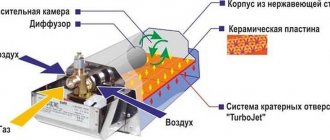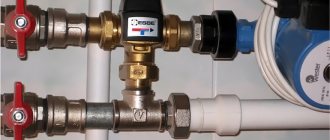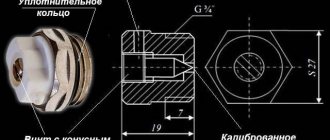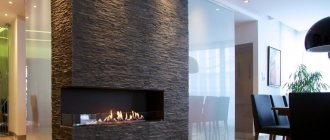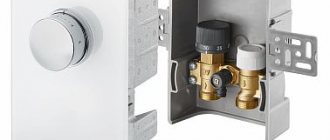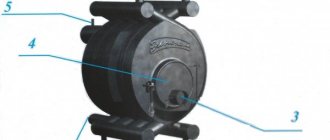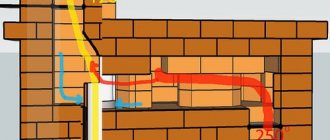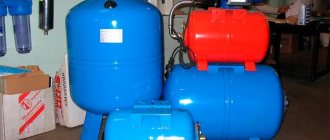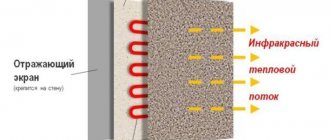What it is?
This is a new generation heating device that can be used in any room. Its installation does not require complex installation work. During operation, the biofireplace does not emit ash, soot, smoke or ash. It does not have an exhaust hood, since the flame is generated by pure organic biofuel. All that is required to install the structure is a small free space in the room, be it a corner, wall or shelf, on which a tabletop biofireplace can be placed. The heating device can also be located in the center of the room.
A few words about the origin
When the biofireplace appeared, Europeans were the first to know what it was in 1977. A patent for the invention of a stove without a chimney was received by a resident of Italy, Giuseppe Lucifora, who used alcohol as a combustible material. Since that time, interest in an environmentally friendly hearth began to grow steadily. The fireplace, as a fashionable room decor, was appreciated by interior designers, because it is very convenient to use, since it is not tied to electricity and communications.
In Russia, the demand for the new invention was low, since the bio-fireplace, whose price was thousands of dollars, could not compete with traditional models with chimneys. Only a few years ago, self-contained biofuel fireplaces began to attract interest on a par with electric fireplaces. And later, models appeared at quite affordable prices for the Russian average (on average, from 30 thousand rubles for floor and wall models).
Advantages, disadvantages and features
The popularity of biofireplaces is understandable; they have a number of undeniable advantages.
Pros of biofireplaces:
- they can be installed in any house, apartment or office;
- there is no need to connect to the chimney and coordinate with the fire department;
- biofireplaces are easy to use, easy to light and extinguish;
- desktop models are mobile - they can be easily rearranged and even moved to another room;
- when burning biofuel, the fireplace does not emit harmful gases, soot, soot, and does not pollute the air and household items;
- A large selection of shapes, sizes and designs allows you to choose a bio-fireplace to suit every taste.
It should be remembered that when bioethanol burns, oxygen is absorbed from the air and carbon dioxide is released, so it is necessary to ventilate the room during its operation.
Owner reviews also point out the disadvantages of biofuel fireplaces :
- Unlike wood-burning, gas and electric fireplaces, a bio-fireplace cannot be used to heat a room; it produces little heat;
- the cost of the biofireplaces themselves and the liquid used for them is quite high and not everyone can afford it;
- Open flames and flammable liquids are potential sources of fire, so care must be taken when handling and storing biofuels.
Despite the disadvantages of using a biofuel fireplace, the advantages are still more significant, so owners of stylish apartments and houses are increasingly giving preference to them, despite the high price.
When installing stoves and boilers operating on solid fuel or gas, it is necessary to correctly select and install not only the unit itself, but also the chimney. We describe in detail how to do this with your own hands in this article. Here we give recommendations for effective chimney cleaning. How to act if reverse draft occurs - read here.
No. 2. Biofireplace: advantages and disadvantages
All the advantages of a biofireplace are clear from the principle of its operation. Manufacturers say that such fireplaces have no disadvantages at all, but those who have already bought a biofireplace know that there are still disadvantages. Let's be objective and list all the pros and cons of such portals.
The main advantages of biofireplaces:
- Possibility of installation in a city apartment. There is no need to install a chimney or obtain permits;
- unique interior decoration;
- versatility. The bio-fireplace can be placed in any room, or even installed outdoors. Often such fireplaces are used to decorate a relaxation area in a country house;
- relaxation, relaxation and aesthetic pleasure from contemplating the flame;
- live fire, according to doctors, improves well-being and helps restore energy;
- The bio-fireplace provides warmth, so in winter you can not only admire it, but also warm up. Just what you need for long cold evenings;
- ease of operation. No special skills are required to turn on the biofireplace. Each of us can operate such a fireplace, if, of course, we are ready to follow some safety rules;
- safety. No carbon monoxide is produced during the combustion process;
- a biofireplace does not dry out the air - on the contrary, it helps to humidify it, and in winter this is very necessary. During the combustion process, water vapor is released, which saturates the air with moisture;
- tabletop and floor-standing fireplaces are mobile, they can be moved from place to place or taken outside. Naturally, built-in models lack such mobility. You can’t really move those fireplaces that are equipped with additional functions, the implementation of which requires connection to an outlet. However, most biofireplaces do not require a network connection;
- huge assortment. Fireplaces differ in shape, size, and decor, so choosing the right model is not difficult. If you don’t find anything suitable in the store, you can make a fireplace of the required shape to order. Moreover, a biofireplace can be built, for example, into a transparent partition between the kitchen and living room. There can be a lot of solutions.
When deciding to buy a biofireplace, you need to know about some of its disadvantages:
- high-quality bio-fireplaces are not a cheap pleasure;
- Since there is a real fire burning in the hearth, you should be extremely attentive and careful. This is not an electric fireplace, so it is better to remove all flammable objects from the immediate vicinity. You should only refuel a cooled fireplace, and do this with extreme caution;
- You won’t hear the crackling of logs, because this is not a traditional fireplace. If this cozy sound is important to you, then it is better to refuse to buy a bio-fireplace. However, manufacturers have already learned to “sound” fireplaces - the most advanced models can, if necessary, include the recorded sound of burning wood;
- if you decide to build a fireplace into the wall and place a television panel on top, you will have to install a heat-insulating screen, since a significant amount of heat emanates from the fireplace, which can damage the equipment;
- some users complain about a subtle, but not very pleasant smell of fuel, although manufacturers note that it has no smell. Some people note that when the fireplace is used for a long time, their eyes begin to water. At the same time, some do not notice any changes at all. Most likely, the matter is not in the sensitivity of smell, but in the quality of ventilation organization. It is very important when there is a fire burning at home for several hours in a row. So before purchasing, make sure that there is enough fresh air coming into the room. If you are going to install a fireplace in the kitchen or bathroom (the ventilation always works well there), on the balcony or in the summer cottage, then there should be no problems. The quality of the fuel is also important. Attempts to save money lead to disastrous results, and high-quality fuel has almost no odor;
- you will have to constantly buy fuel, a liter of which costs about 200-300 rubles.
Classification of biofireplaces
Depending on the installation location, biofireplaces are:
Wall-mounted biofireplace – placed on the wall. Most often, its dimensions are small: no more than 1000 mm in length and 150-250 mm in depth, but with individual production of a biofireplace, the dimensions can be increased.
A tabletop (so-called “bio-candle”) is a portable, portable fireplace that can be placed anywhere on the table. It is made in various geometric shapes (rectangular, oval, bowl, cylinder). Most desktop models, for safety reasons, are protected on two or four sides by glass walls.
Floor-standing (wall-mounted, central-standing) is a bio-fireplace that is installed on the floor surface in the middle of the room or near the wall. Such models are made from various materials: metal, natural stone, glass, ceramics, wood, steel.
Built-in bio-fireplace , or hearth, is built into a niche or small opening in the wall, which is designed before the construction of the building begins or can be made locally where this is permissible. Before installation, a protective box is also built into the niche.
Corner bio-fireplace - usually installed right in the corner, at the junction of two walls. Such fireplaces are compact and take up minimal space. Corner fireplaces can also be floor- or wall-mounted.
Outdoor - fireplaces that are installed in the yard, on a green roof, etc. Such fireplaces are large in size and weight.
Depending on the mode of operation, ignition and extinguishing, biofireplaces are divided into:
- mechanical;
- semi-automatic;
- automatic.
Types of biofireplaces
Depending on the intended installation location, design and dimensions, the following types of biofireplaces are distinguished.
Floor-standing
They are solid and massive structures. They can be placed anywhere in the room, including directly next to the wall. The design of the device can be very diverse. Inserts made of colored glass, forged elements and carved metal sheets can be used to decorate the body.
Ceramic firewood, which can imitate deciduous or coniferous trees, is used as fuel for floor-mounted biofireplaces. Thanks to the use of these accessories, the appearance of the structure is as close as possible to a classic fireplace.
Round or small chipped stones can be used to decorate the burner, creating the effect of natural fire.
Wall mounted
Such models involve mounting on the wall at different heights. They are lightweight and equipped with fire-resistant screens located on all three sides. The back wall is made of heat-resistant materials.
Tabletop
Spectacular compact devices that can make the interior of a room more original. As a rule, they have a metal body, which is filled with small stones. The device is equipped with transparent glass located around the entire perimeter. The main advantage of tabletop biofireplaces is low fuel consumption.
Principle of operation
The basic principle of operation of these fireplaces is identical to traditional ones - fuel is burned in a combustion chamber or niche, which provokes the formation of fire and heat. But there is a fundamental difference. Thus, biofireplaces use exclusively “biofuel” - bioethanol or alcohol, which does not produce combustion products and smoke. At the same time, the flame in such devices is as real as it gets, it’s just of a different type – not as hot as from wood, calmer and extremely safe. Unlike wood, a flame in a biofireplace is formed due to the combustion of fuel vapors - bioethanol, mixed with oxygen, while during combustion no soot, smoke or even sparks are formed. The absence of combustion products inherent in wood is due to the fact that the burning fuel breaks down into two simple and safe components - carbon dioxide and steam. Thus, such fireplaces do not require a chimney to operate, which is a key advantage.
Advantages
- The main advantage of biofireplaces is environmental friendliness. They do not emit carbon dioxide and water vapor. Scientists have proven that one such alcohol burner burns as much oxygen as a regular candle.
- The biofireplace is a completely safe device , easy to install, and maintenance does not require significant material costs. It is only necessary to periodically wipe the burner.
- You do not need to carry out any additional engineering communications. Biofireplaces do not require chimneys or hoods.
- Biofuel consumption is low, so operating a biofireplace will not put a dent in your pocket.
- The device can significantly decorate any interior, and the variety of models will allow you to choose the right option for any room.
- You can decorate your bio-fireplace yourself with decorative stones and other non-combustible elements. Imitation of firewood or smoldering coals is possible.
- Modern models are equipped with a variety of functions and capabilities. One of these is sound. Along with a real fire, you can enjoy the sound of crackling wood.
- The combustion temperature of biofuel is not high, so the biofireplace can be installed at a distance of one meter from the TV or other devices.
- Almost all models are equipped with thermoplastic that protects from flames. It is practically invisible and can protect against burns.
Design and configuration of biofuel fireplaces
The designs of biofireplaces include a special tank or container into which fuel is poured. Some models may be equipped with burners and nozzles. The design of such fires also often includes a special damper, with the help of which the supply of oxygen to combustion is abruptly stopped and the fire goes out. Ignition or extinguishing of the flame in these fireplaces occurs very quickly.
To ensure maximum safety and practicality, many models of biofoci are equipped with special technical solutions. For example, special protection for the fuel tank, which prevents fuel from spilling out in the event of an unexpected overturning of the product. Many models in a higher price category are equipped with automation and sensors that monitor all operating and combustion processes in the hearth. Automation is also capable of abruptly stopping the operation of the fireplace in the event of an accident or incorrect operation of the product systems.
The main design of biofoci consists of:
- Fuel block (alcohol tank and burner)
- Main building
- decorative body (portal, cladding)
Depending on the model, configuration, dimensions and class, the biofireplace package may also include:
- automatic control system or unit (ignition and extinguishing, safety control, change of combustion modes, flame intensity and temperature level)
- unit and remote control at a distance
- audio module for simulating the sound of a burning fire and crackling wood
- steam generator to simulate smoke
- LED backlight to enhance the visual component of the flame
- decorative elements in the firebox (imitation firewood, etc.)
A decorative body—the lining of the fireplaces—can be considered a separate structural element. As a rule, it is this moment that is responsible for the design execution of the product, making it an independent and very advantageous participant in the interior.
Kinds
Biofireplaces can be divided into several types, differing in location and method of installation:
Floor bio fireplaces
Particularly popular because the appearance of the models is closest to the classic look and have a high-strength body and portal.
Near-wall
Possibility to enjoy the view of the fire from only three sides. Made from natural or artificial stone. Despite the massiveness, mobility is not lost. Stable. Can be installed in open space. The peculiarity of this type is that the bottom of the bio-fireplace remains cool for safety reasons for the floor covering.
For location in the center of the room
They are made of glass with metal elements, and the fire can be seen from anywhere in the room. Installation in open space is difficult due to the uneven soil surface.
Wall mounted
Relatively small in size compared to floor-mounted ones.
There are 2 subspecies:
- Open fuel block - having the shape of a shelf, fenced with glass panels or grilles on one side or more. Perhaps the only drawback of this type is installation at a distance of at least one meter from furniture, curtains and other items prone to rapid fire.
- Closed. It is installed on the wall and looks like a painting. Produced in the form of glass blocks of different sizes. The front side is equipped with an openwork grille.
Desktop view
Compact, equipped with a small burner. It has high protection against fuel leakage in case of overturning.
Inline view
Installed exclusively in a niche. The closed top is made of fireproof tile or stone.
Outdoor bio-fireplace
The base is stable and can be installed on any type of surface. Characterized by the ability to enjoy fire from any side.
Installation methods
Every year, miracle fireplaces are becoming more and more popular, so designers are trying to diversify their appearance and come up with different shapes for the devices. This approach allows you to choose the right heater option for almost any room, since they always fit into the interior. Biofireplaces come in three types.
- wall;
- floor;
- desktop
Among the floor-standing ones you can see a wide variety of fireplace models, which in appearance are almost no different from classic fireplaces.
They can be easily installed against the wall so that the fireplace stands permanently in a specially designated place. It can be equipped with wood, stone or metal. When the fire starts to burn, heat-resistant ceramic logs are not much different from ordinary ones. Floor-standing types of fireplaces can be an interesting and unusual solution; they can be mobile or stationary. The mobile option is convenient because the fireplace can be moved to the desired location. In their shape they look much more original than classic models.
Wall-type biofireplaces can be wall-mounted or built-in. It is quite clear that built-in views require a special niche in the wall. The easiest way to make such a niche is with drywall. Wall-mounted models are very relevant, they do not take up free space and fit succinctly into a modern interior. Table-top fireplaces are small in size, look like a large bowl, and have the shape of a cylinder or box. The fireplace body is most often made of glass or polished steel. The tabletop fireplace is complemented by decor made of artificial or natural stone. Such models can always decorate the table and turn an ordinary home dinner into a romantic evening.
Corner fireplaces are also made, which is very important for small-sized housing. They do not take up much space, creating comfort and harmony in the home. There is also the option of a coffee table or coffee table; they perform two functions at once - a fire source and a small table.
There are designers who can make bio-fireplaces to order. They can have multiple fire burners, creating beautiful and unusual fire lines.
Mechanical biofireplaces
Mechanical biofireplaces consist of:
- fuel block providing a living flame;
- housings;
- ignition system and lid, which allows you to extinguish the fire.
Design of a biofireplace of the hearth type
Fuel block (burner)
Only high-quality materials should be used for the biofireplace burner The best option is high-quality stainless steel. BIOART fuel blocks use high-quality heat-resistant stainless steel 5 mm thick. This material is least susceptible to oxidation and high temperatures. When heated, such steel will not deform.
All fuel blocks produced by BIOART are closed type; it is not the fuel itself that burns in them , but its vapor . This design allows you to turn the fuel block in any direction, but fuel will not spill out of it. The vapor combustion process significantly saves fuel consumption (about 1.5 times).
Advantages of BIOART biofireplaces
More information about the types of burners for bio-fireplaces can be found in our blog in the article “Types of burner designs for bio-fireplaces”.
Biofireplace body
The body of a biofireplace is its decorative part, which can be made from a variety of materials. Depending on the decorative purpose and the place where the fireplace will be placed, you can choose the following types of cases:
— panoramic housings that allow you to look at the fire from any of the 4 sides (for example, made of tempered glass or bio-fireplaces “glasses”). Biofireplaces with panoramic casings are more suitable for restaurants, pubs, bars, sofas, clubs;
- built-in - suitable for creating the illusion of a real wood-burning home fireplace. Installed in the wall. Built-in enclosures provide visibility only from the front.
Specially painted steel, metal, stones, marble, granite, veneer or fire-resistant glass can be used as decor and cladding for a biofireplace.
How does a biofireplace work?
Do you want to enjoy a live fire at home? Today this can be done without problems. The solution is a biofireplace - a device that is environmentally friendly to the environment, has benefits for human health and does not require a hood or chimney supply. To install a structure of any size, permission from utility services and redevelopment will not be required. No hassle - only benefits!
What is a biofireplace and how does it work?
Since such fireplaces have just begun to conquer the market, many potential buyers are interested in the design of a biofireplace, and it is as simple as possible.
Rice. 1 Bio-fireplace in the living room interior
The main feature of the structure is its special fuel – bioethanol. When the substance burns, it does not emit smoke, soot, soot or an unpleasant odor - only water vapor, which moisturizes the dry indoor air, and carbon dioxide, which is impossible to escape (any combustion is accompanied by the release of CO2).
Rice. 2 Qualities of biofireplaces
Biofireplace: principle of operation
Biofireplaces are designed according to the principle of a traditional burner: fuel is supplied from the tank to the burner or nozzle, where combustion occurs. The design does not have any innovations. Everything is elementary clear, so much so that you can make the structure even at home.
Biofireplace: design:
- frame;
- fuel block;
- protective screen.
The body of the structure depends on the type of fireplace. The following options are available:
- floor;
- desktop;
- wall;
- street;
- built-in;
- angular;
- bio-fireplace table;
- and many others.
Rice. 3 Tabletop biofireplace in a modern style
The body design serves two main purposes.
- Keep heat inside, avoiding heating surrounding objects and surfaces, ensuring safety.
- Create an aesthetic appearance that will enliven and complement the interior of any style.
Fire-resistant glass, portals and other elements are often used to provide additional protection against burns and heat.
The design of the structure is created not only by the frame, but also by all kinds of decorative elements. For example, ceramic dummies of firewood, stones, including artificial ones. In short, the decoration of the structure is limited only by flights of fancy.
Biofireplace: operating principle of the fuel block
There are 2 types of combustion chamber:
- tank with burner;
- fuel block with tank.
Let's consider each option separately.
Regular burner
The first option is more primitive. In fact, no fire control is performed. The only thing that can be done is to extinguish the fire with a special cap or a valve on the tank (rarely). After all the bioethanol has burned, the tank is replaced. In other words, we have a standard alcohol burner running on environmentally friendly fuel.
Rice. 4 Burner for bio-fireplace
Advantages of a tank with a burner:
- practicality;
- relative efficiency;
- the ability to select fuel with flavorings;
- mobility and compactness.
Flaws:
- lack of protective elements;
- impossibility of refueling;
- lack of regulatory elements;
- possible difficulties in extinguishing the flame.
Despite the existing shortcomings, the simplicity of the device has fans. There are models of biofireplaces that have special slots for installing such burner tanks.
Fuel blocks
Biofireplaces, the operating principle of which is based on a modern fuel unit, are much more complex and reliable.
Rice. 5 Rectangular bio fireplace
The design of the tank differs significantly from a simple burner. The walls of the tank are most often made of stainless steel, more than 2 mm thick. The capacity depends on the model - today it ranges from 2-9 liters, if you do not take into account portable desktop products.
The design of the tank is as follows.
- Inside the tank there is a ceramic filler with pores that absorb bioethanol.
- On the top of the outer side there is a hole - a filling neck through which fuel is supplied. In some models, refueling is carried out through a burner.
- The edges around the perimeter of the top cover provide protection against spillage.
Please note that it is not the fuel itself that burns, but its vapor. This provides additional savings and complete combustion of the substance. The bioethanol filled into the tank is absorbed by the filler, and its vapors flow through the nozzle to the burner.
Control systems
Automation and optimization are key aspects of modern society. It is not surprising that bio-fireplaces, cutting-edge appliances, use advanced technologies. Modern models are equipped with an electronic control system that regulates the operation of the structure. However, there are simpler options that are cheaper, but are not able to provide the same level of comfort, reliability and safety.
Control types:
- automatic;
- semi-automatic;
- manual.
Let's look at the options from simple to complex.
Mechanical adjustment
These models lack electronics and a control panel. Fire adjustment is carried out mechanically by moving the valve. There are no sensors or warning systems provided here.
Advantages:
- simplicity;
- availability;
- no need for electricity.
Such models are usually intended for the street and open air, but there are exceptions.
Flaws:
- difficulty in adjusting the fire;
- lack of important protective elements.
The number of models with mechanical control is gradually decreasing, giving way to advanced electronic analogues.
Semi-automatic operation
Unlike the previous version, there is already a control panel with a screen that allows you to select operating modes. The functionality of the structure is higher, but seriously inferior to automatic systems.
Advantages:
- several operating modes;
- presence of sensors (depending on the model);
- comfortable control;
- low power consumption.
Flaws:
- inability to accurately adjust the flame;
- lack of remote control;
- minimum set of adjustments (compared to automatic).
This option is a balanced solution between ultra-modern, but expensive automatic biofireplaces, and inexpensive, but difficult to operate mechanical ones.
Automatic models
This is where the power of technology comes into play. The device is easy to use, reliable and safe. As a rule, in such products the number of sensors is maximum, which allows the system to prevent the consequences of extreme situations. For example, if a leak or tipover occurs, the fuel supply will be cut off. The only drawback is the fairly high price, but it's worth it!
Rice. 6 Remote control of biofireplaces
The principle of operation of a biofireplace for an apartment
Let's summarize the description. The functioning of the structure is as follows.
- The user pours bioethanol into the tank.
- The fuel is absorbed by the filler.
- Fuel vapor is supplied to the injectors, where it is burned.
- As a result of combustion, carbon dioxide and water vapor are released.
- Other details of the operation depend on the model and installed control system.
If you want to study in depth the operation of such equipment, we advise you to find a detailed device for a biofireplace: drawings, characteristics, dimensions, etc.
This is not enough, then look at the principle of operation of a biofireplace, videos of which can be found on the Internet.
Automatic bio fireplaces
The automatic biofireplace BIOART is a unique innovative development of our company’s specialists, which has no analogues on the biofireplace equipment market in Russia. This model is equipped with a control panel with automatic 3-level (2-level - semi-automatic) flame adjustment and a liquid crystal display that reports all changes in the operation of the device. The automatic bio-fireplace can be controlled from the remote control; it can be connected to a smartphone and WiFi; The semi-automatic bio-fireplace is equipped with push-button control.
The fireplace is equipped with a whole system of safety sensors that monitor the fuel level and temperature of the device.
Installation of a biofireplace
The installation location of the biofireplace is determined by the design features of the specific model. The installation of a bio fireplace can be done either with the help of specialists or on your own.
A fireplace with the “bio” prefix is a “highlight” of any interior, regardless of whether it is hung on the wall, suspended on mounts, placed on the floor, table or built into furniture. Some models of bio-fireplaces can be built into portals for wood-burning or coal fireplaces.
How to choose a biofireplace?
Appearance is not the only thing people pay attention to when studying the assortment in a store. The set of technical characteristics will help you choose the model that will be ideal for a particular room. When purchasing, you need to get acquainted with several important parameters. The list of properties includes:
- Biofireplace power. This is synonymous with the height of the flame, its saturation, and the heat transfer of the device. This figure for the most powerful devices can reach 7 kW. This value will make it possible to heat a room whose area is about 70 m2. However, we must take into account that in the summer it will not be very comfortable to be in a room with such a bio-fireplace: the heat will be very strong.
- Fuel tank volume. The larger the capacity, the longer the fireplace will burn after refueling the device. The maximum volume of the tank is 9 liters, but even with its smaller capacity, the main condition for filling a new portion is its emptying. We must allow the fuel to burn out completely.
- Burner: its material and thickness. There are two suitable options - ceramic element or stainless steel. The thickness of the last burner must be at least 3 mm, more is better. There are dual-circuit designs that return excess fuel to the fuel unit.
- Fuel consumption. It depends only on the operating mode chosen by the owners. If we take average numbers as an example, then we need to focus on 300-700 ml per hour.
All these characteristics cannot be considered separately, without taking into account the future room chosen for installing the fireplace. For example, if the owner’s goal is heating, then it is irrational to buy such a fireplace, since the price of biofuel is quite high. Due to the growing concentration of carbon dioxide, the room will have to be ventilated frequently, so this “duet” - a small space plus a powerful device - will require frequent opening of windows or vents.
No. 6. Fuel for biofireplace
How is fuel for biofireplaces produced? Vegetable crops with a high content of sugars and starch are suitable as raw materials. These are beets, cane, grains, legumes, potatoes and some other crops. First, the raw materials are crushed, then fermented, saturating the mass with yeast fungi, and then filtered. As a result, it is possible to obtain 15% ethanol, which then undergoes distillation and processing, increasing the concentration of ethanol. Then additives are added and bioethanol is obtained, a completely natural fuel that burns to form carbon dioxide and water .
Ethanol burns with a blue-yellow flame (blue at the bottom, orange on the tongue), and to maintain aesthetics, manufacturers add special substances to the fuel that change the color of the flame to a deep orange. If the manufacturer is unscrupulous and used not very high-quality ethanol, and even added a “dye” that is far from being the best, then unpleasant odors cannot be avoided.
Some craftsmen make fuel for a biofireplace on their own , mixing 70% ethyl alcohol and gasoline for refilling lighters, but it is better not to carry out such experiments and buy ready-made fuel. It is sold in cans of 2, 2.5, 5 and 10 liters. Approximately 0.35 liters of fuel are burned in 1 hour. Automatic fireplaces, as a rule, are equipped with special modes that save bioethanol.
There are biofireplaces that are “powered” by helium fuel. These are compact products filled with stones. Such fuel burns without odors, but carbon deposits form on the fireplace over time.
Requirements for installation and operation of equipment
The location for the biofireplace determines the type and shape of the selected model. Even the owners themselves can install such a device. However, minimum requirements for its location still exist, since a biofireplace operates with a flame, and therefore produces heat.
- The room should be well ventilated and drafts should be avoided.
- The most powerful devices need spacious rooms. Such devices are not recommended for installation in rooms whose area is less than 25 m2.
- If the owners plan to buy a model with high thermal power, but problems arise with regular ventilation of the room, then installing high-quality supply and exhaust ventilation is no longer an advice, but a requirement.
- Fire left unattended by adults in the household is always a threat, especially for small children and furry (or hairless) curious four-legged “explorers.” Sleeping with a working fireplace is also not recommended.
- The fuel container must always be tightly closed. Fuel is stored far from the fireplace, and refueling the equipment requires turning off and completely cooling the device body.
- Replacing bioethanol with other liquids (gasoline or kerosene) is prohibited.
- When lighting a fireplace, use special long lighters.
Bio-fireplaces are allowed to be installed under or above televisions, but the distance from the line of fire to the television receiver must be at least 1 meter. The distance to other electrical appliances and any flammable objects should be similar.
Portal and design
Judging by the requests on the RuNet, readers are most interested in biofireplaces with a portal “like the real thing.” Their firebox is decorated with ceramic firewood, which is widely sold on Ali Express and similar sites. The difficulty in this case is to maintain the minimum permissible distance from the upper end of the flame to the arch of the firebox (80 cm); this does not always suit the aesthetics and ergonomics of the room.
How to properly make a portal for a stationary bio-fireplace is shown in Fig. What is obvious is that non-combustible materials are used: metal profiles, drywall (gypsum plasterboard). What is not entirely obvious is that the firebox is painted inside with non-flammable paint, for example. acrylic with mineral pigment. It is advisable to paint the vault with heat-resistant (from 400 degrees) enamel.
How to make a bio-fireplace portal from plasterboard
And what is not at all obvious is mineral wool (preferably basalt), on the left in the figure, in the cavities of the frame surrounding the firebox. As for insulation, there is no special need for it, the bio-fireplace hardly heats anyway. But it is highly advisable to saturate the filler of the cavities of the bio-fireplace frame with a fire retardant in advance.
Borax, widely used in wooden construction, is ideal as a fire retardant - when heated above a certain limit, it releases a large volume of crystallization water vapor, and is harmless to people; unless, of course, you eat it with spoons. Suddenly the flame overheats the firebox, the fire retardant will muffle it or completely extinguish it. The borax solution for impregnation is prepared at a rate of approx. 1 glass per 5 liters of water. Lumber is impregnated with a weaker solution, but its impregnation is designed to resist fire once, and the firebox of a homemade bio-fireplace can overheat more than once.
Tabletop biofireplaces are no less popular. Manuals for their manufacture have been repeatedly published in RuNet; Just in case, we are giving a mini master class in drawings.
homemade tabletop biofireplace
A homemade tabletop bio-fireplace (item 1) consists of a body (any vessel suitable in size and design), a round wick burner with a soft wick and a flame cut-off grille. Stones are placed on the grate, firstly, to stabilize the flame and make it less likely to penetrate the evaporator; secondly, coloring the flame, see below. Since a weak flame fluctuates easily and can be knocked down by a breath of air, a tabletop biofireplace is almost always complemented by a glass shell (open casing), glued with silicone and placed on the body. Such a bio-fireplace is refueled with a measured portion of fuel through the grate using a funnel with a narrow spout; is set on fire (started) by a splinter.
Biofuel in a biofireplace
It’s not difficult to understand how a biofireplace works, but what is fuel with the prefix “bio”? Eco-friendly fireplaces were born thanks to the discovery of bioethanol. Despite such a loud name, the substance is familiar: it is industrial alcohol, which is obtained from legumes, grain crops, potatoes, sugar cane or beets.
Fuel advantage
A fireplace fueled by bioethanol promises:
- absence of unpleasant odor, soot, soot;
- light aroma due to the use of special additives;
- no burning splashes or flying sparks;
- economical fuel consumption.
The process of producing ethanol, technical alcohol includes 3 stages. This:
- preliminary preparation of raw materials - grinding;
- then - fermentation using yeast;
- its filtration is the removal of solid biomass from a liquid.
The result is weak ethanol (15%), which is then distilled and concentrated. Additives are added to the resulting ethanol after these operations, turning a simple product into a biological one - bioethanol. Alcohols obtained from organic raw materials (bioethanol, biobutanol, biomethanol), as well as dimethyl ether, are biological and environmentally friendly fuels. When burned, such products release only a small amount of carbon dioxide and distilled water vapor.
Product percentage composition
Colorless and flammable fuel consists of 95% ethyl alcohol. The percentage of other additives looks like this:
- water - 4%;
- bitrex (denatonium benzoate) - 0.01%;
- methyl ethyl ketone (solvent) - 0.5%;
- additives for odor and color - 0.5%.
In its pure form, this alcohol is completely odorless, but some manufacturers add fragrances to its composition. Burning fuel may smell like birch wood, coffee, rosemary, pine needles, etc. Flavored fuel also requires good ventilation.
Other possible (used) additives are sea salt, due to which a crackling sound appears during the combustion process, like real firewood, and special additives that give the flames an orange color.
Bioethanol consumption
What is the biofuel consumption in a biofireplace? It all depends only on the length of the fuel block. For every meter of it, approximately one liter of bioethanol is needed. This volume is enough to keep the fire burning for one hour. Each next liter of fuel will be consumed faster.
No. 5. Safety and choosing a suitable location for a biofireplace
Undoubtedly, a biofireplace is much safer than its traditional counterpart, but it also has fire, so in order to avoid unpleasant and catastrophic consequences, you must be extremely careful and follow some rules:
- There should be no flammable objects nearby. This includes curtains, tablecloths, bedspreads and other textiles, paper wallpaper, etc. If the fireplace is located on the wall or inside it, it is better to remove paintings and photographs from the immediate vicinity;
- It is better not to move a floor-standing fireplace close to the wall - leave a gap of 20-30 cm for better circulation of warm air;
- It is better not to place the fireplace in a draft;
- the distance from the fireplace to the TV and other electrical appliances must be at least 1 m;
- do not forget to clean the fireplace from dust. Special products are provided for cleaning the glass of biofireplaces. Cleaning is carried out after the fireplace has cooled down;
- If fuel spills while pouring fuel, carefully wipe up all drops with a well-absorbing material. Otherwise, the fire may spread far beyond the burner;
- The size of the fireplace must correspond to the dimensions of the room. In a large room, a massive floor-standing fireplace will look beautiful and proportional. If there is not much space, you can take a closer look at wall-mounted or built-in niche options. Compact tabletop fireplaces are available for the smallest spaces. An alternative option is to build the fireplace into furniture, for example, into a coffee table;
- Let us remind you once again about the need to organize ventilation of the room. During the combustion of fuel, oxygen is consumed, so an influx of fresh air is simply necessary. A slightly open window or exhaust ventilation valve will help remove exhaust air with a high content of carbon dioxide. Without a hood and chimney, a biofireplace is not dangerous, but organizing ventilation is the key to your comfort.
Rules for the safe use of fireplaces
Despite the fact that biofireplaces are one of the safest fireplaces in the home , during their operation you need to follow simple rules .
- Models with an open combustion chamber must be installed at a considerable distance from combustible objects: textile interior elements, bookshelves, curtains.
- The surface on which the fireplace is installed must be level and stable, especially for models using liquid fuel.
- You should not leave the fireplace uncontrolled or trust children to light it.
- If the fireplace is not in use for a long time, drain the fuel from it. Bioethanol must be stored in a place that prevents overheating and contact with open fire.
- Fuel can only be added to a fireplace that is extinguished and has completely cooled down.
- Ignition is carried out with a special lighter for bio-fireplaces, which prevents burns.
- Bio-fireplaces can only be decorated using elements specially designed for this purpose: stones, imitation coals and logs made of heat-resistant ceramics.
- Built-in models must be installed in niches made of fire-resistant materials. Considering the numerous advantages and minor disadvantages, biofireplaces have every chance of winning a strong place among designers and owners of stylish apartments and cottages. Their installation and operation does not require extensive repair work; you just need to choose a model according to your taste and financial capabilities.
Review of models: their characteristics and prices
Bari Berloni
Compact Italian model, made of steel with black powder coating. Heat-resistant glass and a steel burner of a bio-fireplace will favorably emphasize the minimalist style of the interior. Stylish design and low weight (3 kg) allow you to install the device on any desktop surface.
Maximum burning time is 2 hours.
Price – 4500 rubles.
Basic Casing 990
Wall-mounted biofireplace. A stylish and bright solution for any interior. Made of high-strength steel, with black powder-coated elements. Equipment assembly required.
Price – 140,000 rubles.
Baveno Berloni
Exquisite Italian premium model. Designed for installation in classrooms and small offices. Ergonomic design will fit into any interior and create an atmosphere of comfort. The body is made of heavy-duty steel; The burner is made of stainless steel. The walls of the biofireplace are made of heavy-duty glass. Device weight – 6 kg.
Price – 14500 rub.
Bubble
A wonderful Polish ergonomic model, made of fire-resistant white plastic. Ultra-modern design suitable for home and office environments. The combustion bowl is enclosed in tempered glass. The weight of the model is 20 kg. Operating time – 2 hours.
Price – 126,000 rubles.
Calvados Ivory Planika
The Polish floor biofireplace is made in a classic design . Easy to install and operate. Ideal for small living spaces. Facing material – ivory.
Price – 145,000 rubles.
Care instructions
Caring for a biofireplace is quite simple. Dust is removed from it with a regular cotton cloth. You can use a special liquid to clean glass surfaces. It is enough to rinse the heating unit with hot water. Before cleaning the fireplace, the main thing is to extinguish the fire and wait for the hearth to cool completely. Never attempt to start a fire with paper, magazine, or other flammable material. Use the special lighter included with the fireplace for these purposes. When operating the device, do not touch heating elements, logs or stones.
Requirements for the room in which the biofireplace is installed
Due to the fact that the device does not require additional installation of special taps, it can be installed almost anywhere. The heating device can be located in a living room, in a country house, in a bar, restaurant, or in the fresh air. Decorative firewood placed in the hearth is made of ceramic stone. They create the effect of natural burning logs. However, there are some requirements for the future location of the bio-fireplace.
If this is a living space, then it must be ventilated. Infiltration during operation of the device should provide the room with a sufficient volume of air. A modern fireplace should not be installed in a cramped space of less than 25 square meters, such as a bathroom or shower room. If the room is isolated, it is recommended to open the existing doors to adjacent rooms during operation of the device. These measures will allow for air exchange and prevent excessive accumulation of carbon dioxide in the room. In a larger room, it is enough to open a window or window. The fuel used is non-toxic and safe to inhale. Any bio-fireplace, tabletop or built-in, can be used as a means of aromatherapy. There are special kits on sale containing aromatic herbs and plants.
Flaws
- To operate a bio-fireplace, you need a room of at least 25 square meters.
- When using powerful bio-fireplaces, the consumption of alcohol fuel will be quite high.
- The price of biofireplaces is quite high, starting from 20 thousand rubles. You can get acquainted with the possible range and approximate cost at this link https://premfire.ru/ .


